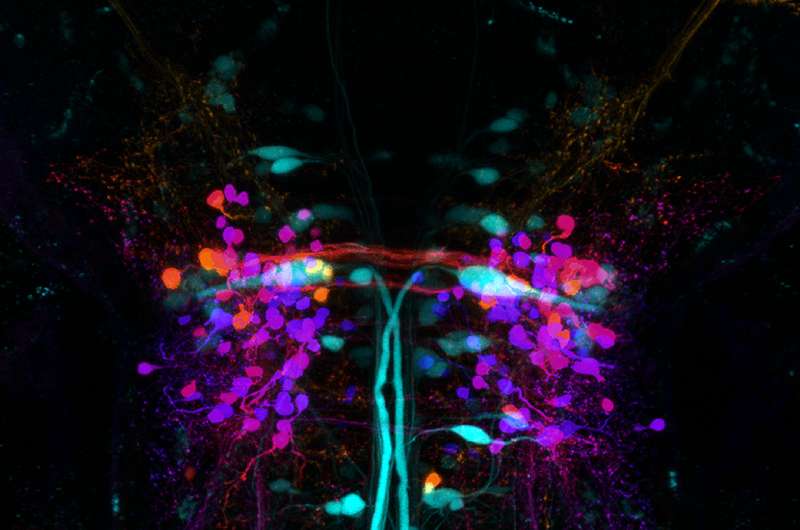Right or left? Study shows how zebrafish answer key question

A small fish swims in a stream, when suddenly it sees a larger fish flashing toward it, mouth open, from the left. The little fish instantly makes a hard right turn and darts away.
Very little is known about the wiring of nerve cells in the brain that allow a fish, or any animal, to make fundamental choices to move to the left or to the right.
A study of zebrafish larvae published Aug. 9 in the journal eLife for the first time reveals a circuit that determines the direction of a lightning-quick turn to escape a predator.
A wiring pattern that gauges the strength of sensory input from the left and from the right excites nerves that control muscle cells on the side of the body that receives stronger input. The decision to turn in one direction is partly made by inhibitory cells that cross the hind-brain's midline and inhibit the nerve cells – and the muscles – on the side with the weaker input.
"By collecting evidence for left versus right alternatives and using a particular wiring pattern, the circuit weighs the evidence in a competitive process to make the correct, critical choice," said Joseph Fetcho, the paper's senior author, professor and associate chair of the Department of Neurobiology and Behavior in the College of Arts and Sciences, and co-director of the new Cornell Neurotech Initiative. "Just one wrong turn in a lifetime can lead to death, so a correct choice matters more than most choices that an animal makes."
The research team used electrophysiology techniques in zebrafish to record three neurons at once, excitatory nerve cells called Mauthner cells that stimulate muscles on the left and on the right, and inhibitory neurons. Then, Fetcho worked with co-author Chris Schaffer, associate professor of biomedical engineering, and his lab, to conduct behavioral experiments where they tested the roles of each cell. They used a technique developed by Schaffer that employs a very precise laser and imaging to burn individual cells deep in the brain and kill them.
"We figured out the circuit, got some ideas of how it might be working, and then predicted what would happen if we killed certain cells," Fetcho said.
Fetcho and the team also found evidence this basic circuit pattern of excitatory and inhibitory nerve cells may rise up in columns, with older cells that control faster movements at the bottom and younger cells controlling slower movements higher up. This architecture is reproduced in all the parts of the brain that control movement. Fetcho believes the basic circuitry for making left/right decisions likely applies to all motor decisions across all species with bilateral brains, and his ongoing studies seek to investigate this hypothesis. It turns out, more than 90 percent of brain organization that produces movements and behavior is shared among all vertebrates.
Also, Fetcho is applying a technique called lightsheet microscopy using engineered zebrafish whose neurons fluoresce when they are electrically activated to test his ideas about brain organization. In this way, he can image nerve cells throughout the spinal cord and brain, which light up when they are active. He is working through the Neurotech Initiative to image all the cells in the zebrafish brain to uncover how brains produce behaviors and movements. Because zebrafish are transparent, they make an ideal model species for imaging the brain and spinal cord, he said.
More information: Minoru Koyama et al. A circuit motif in the zebrafish hindbrain for a two alternative behavioral choice to turn left or right, eLife (2016). DOI: 10.7554/eLife.16808


















